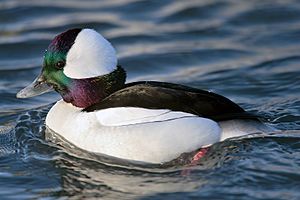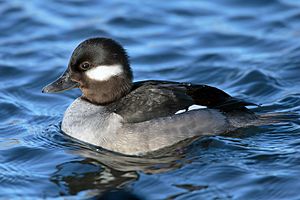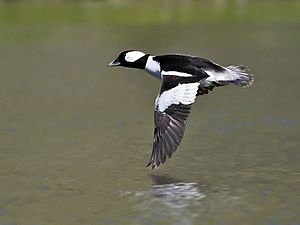Bufflehead facts for kids
Quick facts for kids Bufflehead |
|
|---|---|
 |
|
| Male | |
 |
|
| Female | |
| Conservation status | |
| Scientific classification | |
| Genus: |
Bucephala
|
| Species: |
albeola
|
 |
|
| Synonyms | |
|
|
The bufflehead (Bucephala albeola) is a small type of sea duck. It belongs to a group of ducks called goldeneyes. A famous scientist named Carl Linnaeus first described this duck in 1758.
The name "Bufflehead" comes from the duck's unique head shape. It looks a bit like a buffalo's head, especially when the male puffs out his feathers! The scientific name Bucephala also means "bullheaded" in Greek. The second part of its scientific name, albeola, means "white" in Latin.
Contents
What Does a Bufflehead Look Like?
Buffleheads are small ducks. They are usually about 32–40 cm (13–16 in) long. They weigh between 270–550 g (9.5–19.4 oz). Male buffleheads are a bit bigger than females.
They are one of the smallest ducks in America. They are about 35.5 cm (14.0 in) long. Their wings can spread up to 55 cm (22 in).
Male and Female Buffleheads
Adult male buffleheads are very striking. They have black and white bodies. Their heads shine with green and purple colors. They also have a large white patch behind each eye.
Female buffleheads are mostly grey. They have a smaller white patch behind their eyes. Their undersides are lighter in color.
Where Do Buffleheads Live?
Buffleheads are migratory birds. This means they travel long distances. Most of them spend winter in North America. They like protected coastal waters. They also live in open inland waters. You can find them on the east and west coasts of the United States.
Breeding Grounds
Buffleheads breed in Alaska and Canada. They prefer wooded lakes and ponds. These areas are mostly in the boreal forest or taiga habitats.
Population Changes
From 1966 to 2015, the number of buffleheads grew. Their population increased by more than 1.5% each year. This happened across all their breeding areas.
How Do Buffleheads Behave?
Buffleheads are small and very active. They dive underwater almost all the time. This helps them find food. Their small size helps them fit into certain nesting spots.
They usually do not gather in large groups. You will often see them in small numbers. One duck might act as a lookout. It watches for predators while the others dive for food.
Buffleheads are known for being very punctual. They are among the last ducks to leave their breeding areas. They also arrive at their winter homes at almost the exact same time each year.
Nesting and Raising Young
Buffleheads usually have one partner. Female buffleheads often return to the same nest site every year. They build their nests inside tree holes. They especially like old nests made by northern flicker woodpeckers. These nests are usually close to water.
Smaller tree holes are better for them. This is because larger ducks, like goldeneyes, cannot fit. This means less competition for nesting spots.
Baby Buffleheads
A female bufflehead usually lays about nine eggs. The eggs are about 50.5 by 36.3 mm (1.99 by 1.43 in). It takes about 30 days for the eggs to hatch. Most nests are successful.
About a day after the ducklings hatch, they jump out of the nest hole. They learn to fly when they are about 50 to 55 days old.
What Do Buffleheads Eat?
Buffleheads are diving birds. They find their food underwater. They like water that is between 1.2–4.5 m (3.9–14.8 ft) deep.
In freshwater, they mostly eat insects. In saltwater, they mainly eat crustaceans and mollusks. Sometimes, they also eat aquatic plants and fish eggs. These can be important food sources in certain areas.
Buffleheads and People
Buffleheads are very popular with bird watchers. People enjoy watching them because of their bright colors. They are also very active. They often live near people on waterfront properties.
In 1995, the bufflehead was added to the coat of arms of Sidney, British Columbia. It is also known as the "spirit duck."
Buffleheads are hunted as a game bird. Unlike many other sea ducks, their numbers have stayed steady. The biggest threat to buffleheads is habitat loss. They need specific coastal areas for winter. They also need special forest habitats for breeding. Even though they use man-made nest boxes, they still need healthy forests to survive.
Images for kids
See also
 In Spanish: Porrón coronado para niños
In Spanish: Porrón coronado para niños




